Is Spanish Nymphing a Thing?
(including video below)
I’ve previously said that “the angle that you cast up/across streams” is NOT a good way to separate Spanish nymphing from French nymphing. I still stick by this…
So what ARE the characteristics that mean we should have it in our nymphing “dictionary”?
Not Convinced about Spanish Nymphing? Try it in "Second-hand" Water
Here are just two of what turned into a bit of a landslide of captures in water that had been flogged hard just beforehand...
Forget "Casting Angle" and Look at Function
As with all the other modern Euro nymphing methods covered on Fishing Discoveries pages – each named method is best seen as a short, easy label. Basically, they’re recognisable ways to group together useful ideas and characteristics. That functional way of defining things is much easier to deal with than claiming “one true version” of methods with complicated origin stories.
Instead of casting-angle, I think the construction and performance of the rigs are more useful to focus on.
For Spanish nymphing I reckon the idea of “less at the back” is the key…
Spanish Nymphing leader design: World Champion Version
In the video (below the diagram), current rivers World Champion Howard Croston shares his favourite Spanish leader setup. Here’s a quick sketch so we know what we’re talking about:
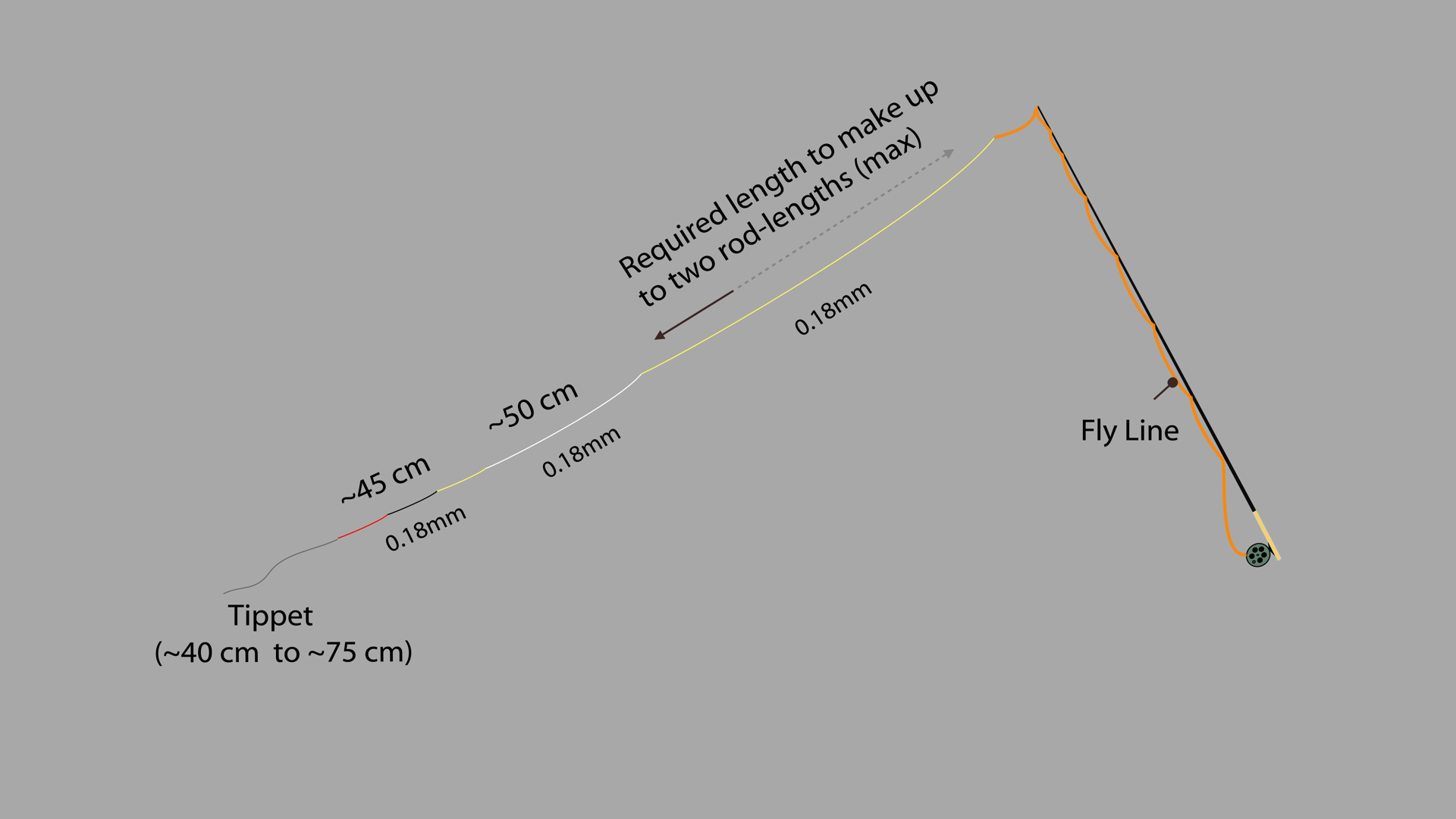
Howard does a great job at breaking down the functional choices behind the leader construction shown above. You can check out more like this on Howard's YouTube Channel.
Please check out what he says in this video, as it REALLY helps you get the most out of the stuff in the rest of this article:
The best Spanish Nymphing Leader Material is French...
At least the best that I know of. It is produced by the Pierre Sempé brand and I'll be writing a lot more about Pierre himself in future. His contribution (and that of the anglers who are following his approach) to both fly fishig and finesse bait fishing is highly significant.
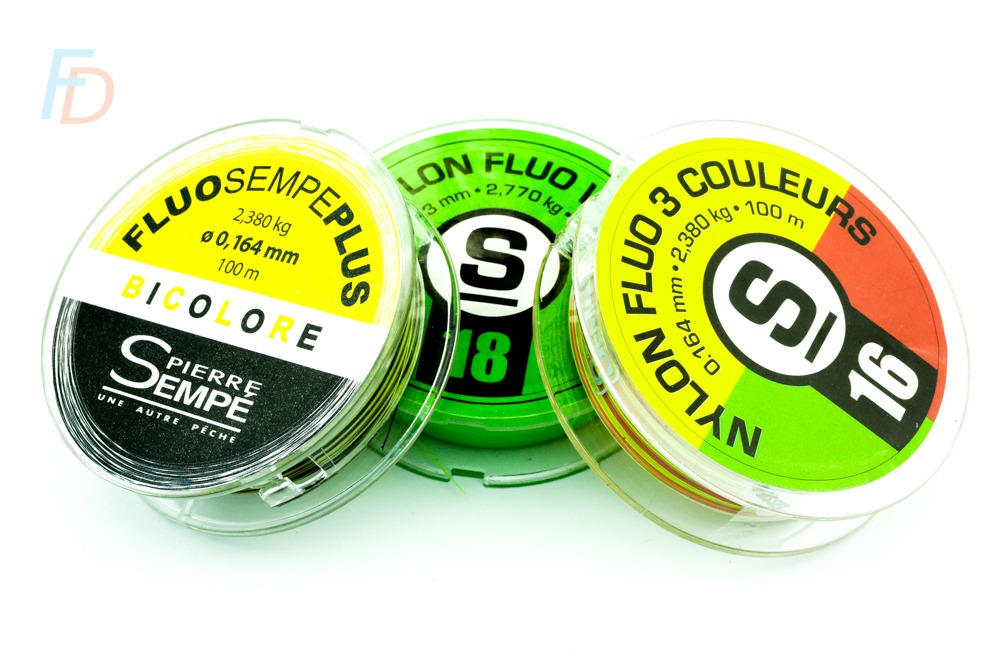
My Current favourite "Spanish" leader is the Green 0.18mm Sempé nylon for the butt section followed by 50cm of the bright 3-colour (0.16mm) & a tip section of two tone yellow and black (0.16mm). I like that it is easily visible, but that I can have the slightly less "spooky" black and yellow at the tip.
Here's where you can get Sempe nylon:
Direct from Sempé - https://www.pierre-sempe.com/110-nylons-soies (just use their contact form to arrange overseas delivery)
Pecheur: https://www.pecheur.com/vente-peche-truite-fils-nylon-835,0,0,0.html (keep scrolling down to find what you need)
Key Functions of Spanish Nymphing leaders (why bother with them?)
You know how “weight forward” (WF) fly lines are much better described as “less weight at the back-ers”? In case you’ve not heard that before, here’s a quick explainer.
It’s not that there’s any more weight added to the front of a WF fly line compared to a Double Taper (DT).
The mass of the standard length of line of one specific AFTM rating is the same between a DT and a WF.
It is just that, as soon as you go beyond the casting “head”, the taper drops quickly to a much narrower running line.
It is reducing weight/diameter/friction at the back-end of the casting system which is important for shooting more line when casting standard fly lines…
In a Spanish leader, the reduction of weight and diameter at the “back end” of the system is also the important detail. Instead of affecting shooting distance in a cast – it reduces two important factors related to drift control…
Drape Otsuri
Otsuri is the change given in stores in Japan. It is also used by Japanese anglers to describe the “change” that is returned to you when you cast further out than the sag of your line will allow. With a high rod tip, the sag “gives you your change” for an overlong cast. In other words, the distance that you “over-paid” is returned to you as the line settles at a balance-point closer to the angler.
Here's a diagram showing that as the diameter and weight of your level fluorocarbon casting line (or French leader) increases - so too does the amount of "drape otsuri":
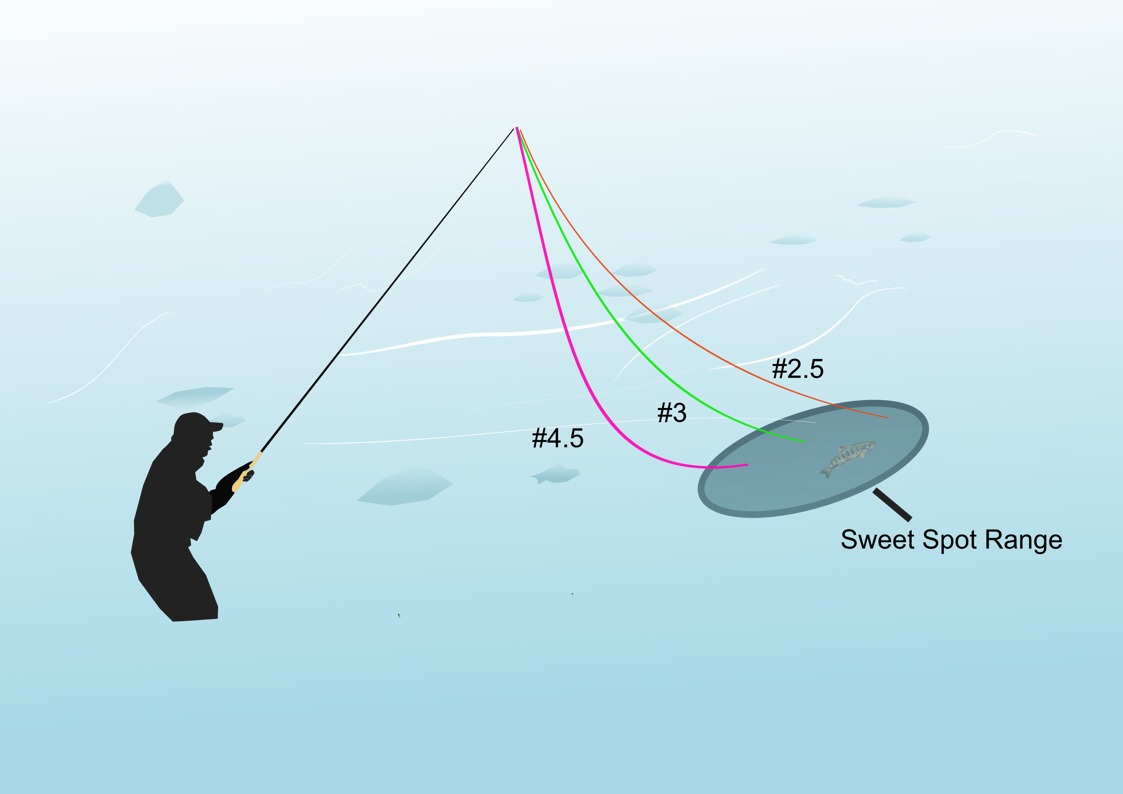
Weighted nymphs have a certain mass/inertia – so there’s an amount of resistance to them being pulled back through the water by line-sag. That resistance is also affected by how streamlined/un-streamlined the fly pattern is.
Although this opens up a whole other line of possibilities with “sight spider” top dropper flies – that’s a whole different article!
Getting back on topic with Spanish nymphing…
There’s a much more detailed examination of “drape otsuri” on our tenkara site. It is worth noting that the rods used to deliver the #3 nylon in that article are casting unweighted wet flies with a “fly casting” loop (#3 nylon is thicker than Howard’s Spanish leader – but not by that much).
People cast #1.75 and #2 diameter fluorocarbon with unweighted flies, which is getting MUCH closer to 0.18mm. Using such light/thin line to fly-cast is only possible when there is ZERO wind…
The interesting point there is that those level lines are used for the exact reason of creating “less weight at the back” – and reducing drape otsuri. It is just that, in Spanish nymphing, it tends to be the weight of the flies that provide the mass for casting. In other words, the "weight forward" part of a Spanish leader is actually concentrated into the flies, rather than the line...
The job of the leader is to, as far as possible, simply not be there at all...
Surface-cutting
Water at the surface of a river TYPICALLY flows faster at the surface than close to the bed. When fishing with sunk flies, then, the pace at the surface is usually different than the pace where your fly is drifting.
The thicker the line that sits on/in the surface – the greater the pull of the water on that line. This means that the thinner your leader/tippet is where it cuts through the surface – the better it “cuts” through that drag. As a result, there is less impact of that fast surface flow pulling on your line – which in turn allows your nymph(s) to drift at a pace closer to that of the water closer to the river bed.
Look at this example of a "cross-current" cast here:

Thicker French Leader (1) showing greater "pulley-wheel" effect than thin Spanish Leader (2). Note difference in contact AND depth of nymph
It’s the line-cutting ability of the thin, level Spanish leader setup that allows the flexibility in depth (while keeping indication). As Howard explains, the ability to keep that “depth-coverage” flexibility without re-rigging is a big advantage.
Combined effects of better surface-cutting & reduced otsuri in Spanish nymphing leaders
There are multiple benefits to reducing the weight towards the butt-end of your leader. For example, you can reach further across-stream while still keeping decent “straight-line drift” ability. In other words, when you reach further over, it doesn't cause the nymphs to arc towards your side of the river due to line-sag/otsuri.
Reduced leader-sag at longer range also gives you a closer match to the true pace of the current when fishing directly upstream.
In both those cases, the longer potential reach – while still creating a great drift – improves your stealth. Separating yourself more from the fish reduces the chances of spooking it – but with many rigs drift quality suffers by the same proportion.
Thin, level Spanish leaders re-balance that trade-off.
It’s not only drift quality that is preserved at greater range. Normally, increasing separation between angler and fly also means a loss of contact. With less contact, you have both poorer bite detection and lower hook-set success.
Creating a straighter line to flies at a slightly longer range increases contact in two key areas:
- Straighter line/less sag from rod tip to surface of water
- Straighter line between water surface and fly (less “pulley wheel” effect)
To expand on that:
Lack of contact between the nymph and line just above the surface is the enemy of bite detection. Slack in that part of the system can absorb the “signal” of your fly being eaten before it is spat.
Lack of contact between the rod tip and the point where the line cuts the surface dulls your hook-set.
This combined effect is the real advantage offered by a Spanish nymphing leader setup – as long as you have the skill to fish it well...
Because...
It is not a magic bullet – and if you can’t deliver your nymphs accurately, create and control great drifts and detect strikes visually by maintaining perfect tracking; it won’t help at all.
Flies for Spanish Nymphing
Unlike French leaders, you'll struggle to throw a dry fly on a Spanish-style leader of the type described by Howard. As with all choices in fishing, each option is a trade-off of different strengths and weaknesses. There's no real single "best option".
That being said, the classic design of flies associated with Spanish nymphing is probably the perdigon (pellet/bullet) style. Originating in the Pyrenees region, it seems to have approximately equal French and Spanish influence in its development.
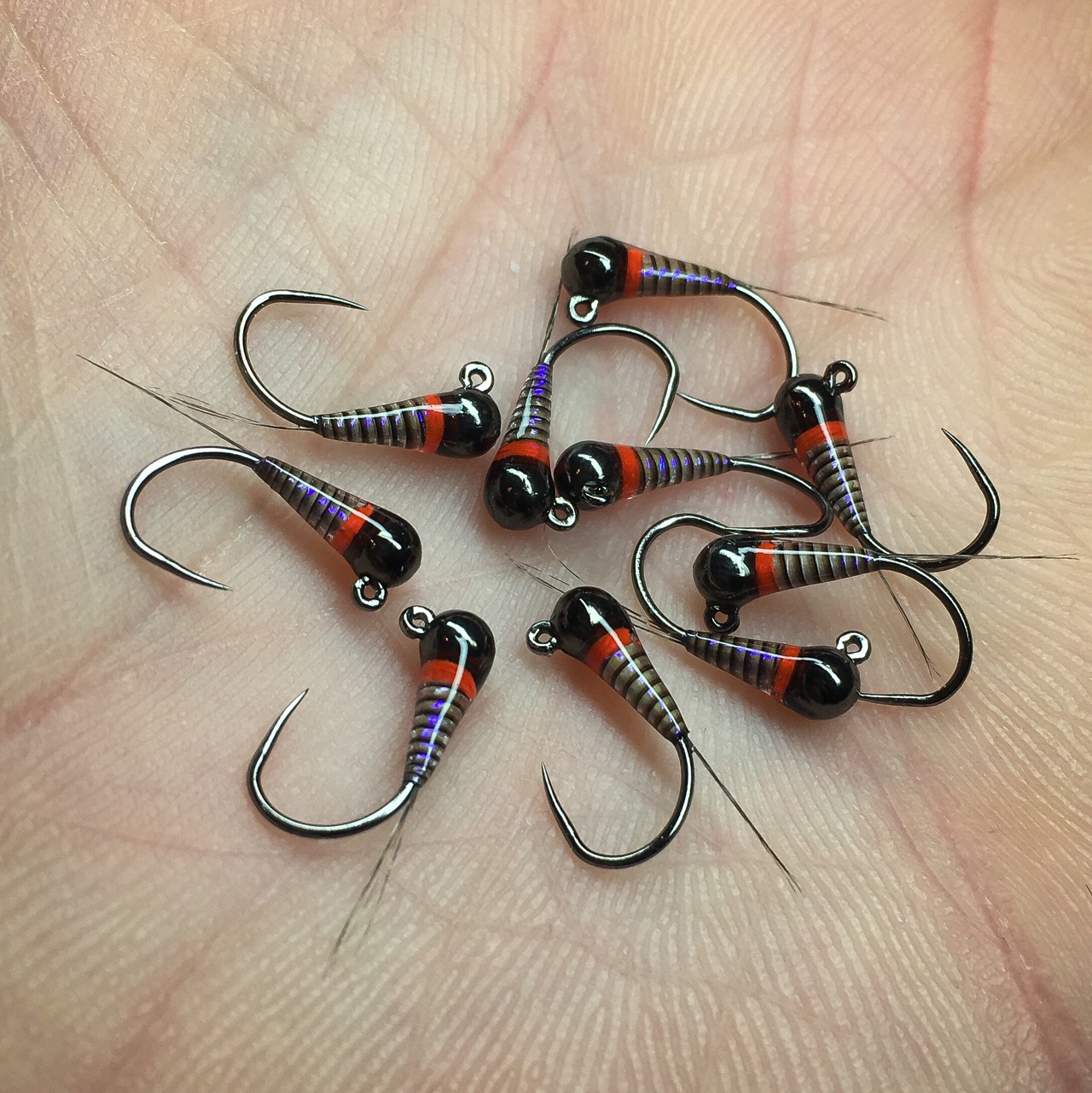
Perdigons tied and photographed by Paul Molloy
The key factors are the ability to create a small nymph which is so dense and streamlined that it can still cut through fast-flowing water of steep, clear mountain rivers.
For stealthy fishing in shallow water (e.g. where Howard relies on a daub of coloured wax for strike indication) - using just a single nymph will be the best option. Don't always default to a pair (or even three) nymphs on your cast.
However, going back to the functional definition of this leader style – it can obviously be used to present a range of flies (not just perdigons). Overall, small, slim flies that have enough density to be cast by your nymphing rod are ideal.
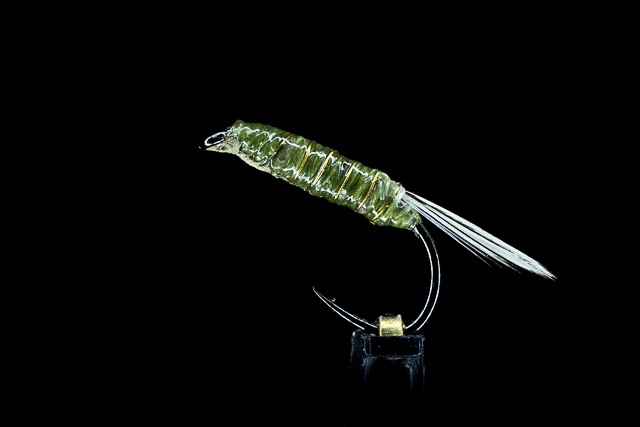
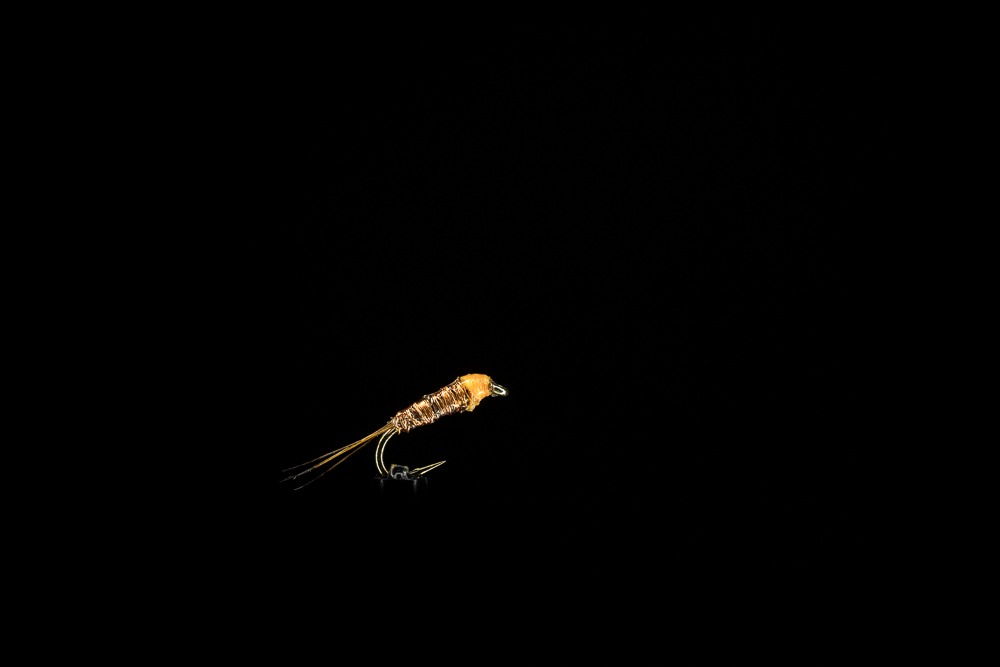
Getting more creative, you can use point flies that provide sufficient weight to deliver a dropper fly (or flies) which might have other physical characteristics. But that’s getting into another chapter of nymphing altogether...
So I'll cover that in future content...
Spanish Nymphing Take-home points:
Thank you to Howard for sharing his Spanish nymphing experience at the highest level
My great thanks to Howard for supporting the idea of using his video in this post (go ahead and give him a subscription on his YouTube channel, you can see that he's putting out tons of valuable info).
As usual - let me know in the comments if you think the information here is worthwhile or makes you think a little differently about your fishing. If you do enjoy it, please share it with your friends (there's handy social media sharing buttons on the page - or you can just copy and paste the URL from the address bar).
If you want nymphing tuition direct to your inbox, there's always my free course - which also keeps you up to date with our new projects and special subscriber bonus offers too:
Best wishes,
Paul

Sorry, the perdigon nymphs was developed in Asturias by José Carlos Rodríguez, who sadly passed away a few weeks ago.
Thank you for this addition and I’m very sorry to hear of José’s passing.
Paul
Wonderful article, Paul. I do have one question, though. I’m a bit confused by your diagram of Howard’s default nymphing leader, specifically by the length of tippet. Your diagram depicts tippet length as short as 16″ and as long as 30″. That is considerably shorter than what I see Euro anglers (some of them comp anglers) use; typically, they seem to have tippets that are around five to six feet in length. Could you talk a little about tippet length in leader setups like Howard’s?
Hi Alex, because the main leader is basically of “Tippet” diameter, Howard is typically using that rig to deliver a single nymph to super spooky fish in shallow water.
Therefore, it’s almost arbitrary to describe the final, transparent, 16″ – 30″ as the actual “tippet” – I hope that makes sense?
Paul
I will definitely be using this leader. It solves the problem of having to add or subtract tippet when moving between different depths, as well as less sag. Thanks for sharing.
Great stuff Harold – let me know how you get on with it. That setup is exceptionally successful in its designed role (particularly for getting those “impossible” fish to take).
Paul